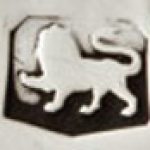Sterling Silver FAQ
Q: How can I tell if an item is sterling silver?
A: An item that is sterling silver will either be stamped “sterling”, “925”, or have a mark on it called “the Lion Passant”. What does the “925” stand for, you may ask? Sterling silver is made up of 92.5% silver and 7.5% alloy metals. Why isn't it 100% pure? Simple. Pure silver is too soft to make into anything that will hold its shape.
Sterling silver will also very often be stamped with a “hallmark” which will help you or an appraiser determine which manufacturer made the piece, when it was made, and where. If you're curious as to what the “Lion Passant” looks like, see the image below.
Q: How should I clean and care for my sterling silver?
A: Silver, when it comes in contact with various substances like sulfur, will tarnish. To prevent tarnishing, it is best to store your sterling silver items in an airtight container or cabinet when not in use. Be sure that your airtight container does not contain rubber, as rubber will actually promote the tarnishing process. Plastic is also not recommended for silver storage.
The best way to avoid tarnishing of your sterling silver items is to use and wash them frequently.
When using your sterling silver items, take care not to leave food in or on them for long periods. Also, avoid contact with acidic foods or foods that contain sulfides like eggs, fruit, ketchup, vinegar, tomatoes, salt, mustard, and salad dressings. Wash any salt off sterling silver items immediately to avoid spotting.
Wash sterling silver with warm sudsy water. Do not wash sterling silver and stainless steel items together. Avoid using abrasives to clean your sterling silver, as it may harm the finish. (Some people advocate using toothpaste to clean silver, but many kinds of toothpaste are actually abrasive.) Avoid cleaning dips that are ammonia-based. These types of cleaners may eat away at the finish of your sterling silver. Immediately dry all washed silver with a cotton cloth.
When handling and cleaning silver, use plastic or cotton gloves, as rubber gloves may tarnish the items you're trying to clean. Avoid rubbing and polishing your sterling silver items excessively. All rubbing and polishing removes silver, albeit very small amounts, and may dull some of the distinctive etching in your sterling silver pieces.
Q: Can you tell me the difference between a Place Set, Dinner Set, and Continental Set?
A: The quick answer to this is that the size of the fork and knife are different for each set. In the Place Set, the knife is approximately 9″ long and the fork is 7 1/2″ long. In the Dinner Set, the knife and fork are both 1/2″ longer than the Place Set. The knife and fork in the Continental Set are even longer than the Dinner Set.
Q: I have seen HH and FH in reference to sterling silver. What do those abbreviations mean?
A: HH stands for Hollow Handle. Knives are made differently from other flatware pieces. The handle of the knife is hollow and a stainless steel blade is secured inside the hollow of the handle.
FH stands for Flat Handle. Flat Handle usually refers to individual butter spreaders which are available in the Hollow Handle or all-sterling Flat Handle.
Click here for more Sterling Silver Resources.

